There once was a man from Meron, who came to visit Jerusalem . . .
Sounds like a good beginning to a story, doesn’t it? While the tale in Bava Batra 156b is about how this man circumvented a problem of transferring property, we will focus on where he came from. What is a “Meroni?”
The parallel text of our story is in Kiddushin 26b, where the man is called a “Medoni,” is this the same place as Meron? Or perhaps the name is really Merom? Rashi in Kiddushin refers us to the book of Joshua, where Madon is mentioned as one of the Canaanite kingdoms conquered by the Israelites:
“the king of Madon one, the king of Hatzor one” (Joshua 12:19)
These kingdoms are listed in geographical order and Madon’s neighbor is Hatzor, the massive Canaanite city in the north, near Tzfat of today. If we go back a chapter, we hear about the great battle of Joshua against these northern kings which took place in Merom:
“So Joshua, with all his combat troops, came upon them suddenly at the Waters of Merom, and pounced upon them.” (Joshua 11:7)
Are Meron/Medon/Merom all the same place? We are not sure, but we can definitely place our Meron/Medon in the Upper Galilee, somewhere near Hatzor. This was a region that was significant in Mishnaic and Talmudic times, with a strong Jewish presence. Archaeologists have found remains of dozens of Jewish villages and synagogues in the Galilee and our man from Meron/Medon would likely have lived somewhere in that region.
Meron is a village on the slopes of Mount Meron, one of the tallest mountains in Israel. It was a strategic point, with battles taking place there in Canaanite times, as well as during the Great Revolt when it was fortified by Josephus. In modern times, Meron was captured by Arabs in the War of Independence but freed in October 1948, afterwards becoming a Jewish village once again.
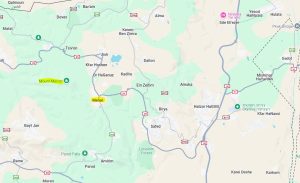
In Second Temple times and later, Meron seems to have been the home of one of the orders of the priests, the mishmarot kahuna. These twenty-four priestly families lived in different parts of Israel. These locations are preserved for us both in archaeological signs, like lists that were prominently displayed in synagogues, as well as in a famous early medieval poem called Havatzelet haSharon. The first paragraph tells of the Yehoyariv family, kohanim from Meron:
וְנָעוּ מִמִּשְׁמְרוֹתָם כֹּהֲנִים בְּנֵי אַהֲרֹן
כְּנִמְסַר הַבַּיִת בִּמְסָרְבֵי מָרוֹן
“And the priests, sons of Aaron, left their posts
As they gave away the house (Temple) like rebels” (a play on Meron) (Havatzelet haSharon)
Meron is most famous for being the home and later the burial place of Rabbi Shimon bar Yohai and his son Rabbi Elazar (see here). While the Upper Galilee is full of graves of Tannaim and Amoraim, many of them identified by Rabbi Isaac Luria (the ARI) in the sixteenth century, the ones in Meron are by far the most famous and the most visited. Pilgrimages began already in medieval times and today there are tens of thousands of visitors, especially on Lag BaOmer, Rabbi Shimon’s traditional yahrzeit (although this has changed since the terrible Meron tragedy in 2021, and now the war, as the government has limited visitors).
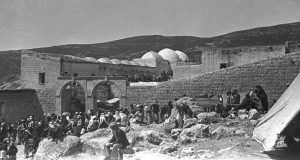
Pilgrimage to Meron 1939
Hans Pinn, Public domain, via Wikimedia Commons
Today most visitors to RaSHbI’s grave do not bother to trek up the hill at the edge of the parking lot. However, if they did they would be rewarded by the sight of one of the most impressive synagogues from Mishnaic times. The massive lintel and doorways indicate an elaborate synagogue that was built in the third century CE, slightly after RaSHbI’s time. It was not used for too long since an earthquake destroyed much of it in the fourth century.
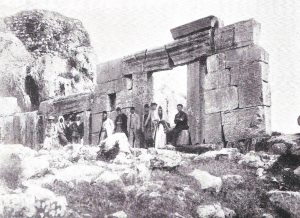
Synagogue 1899 Public domain, via Wikimedia Commons
Could this have been the synagogue of our Meroni?
Legend says that when the lintel, which is none too stable, finally falls, the Messiah will come. Today it has been cemented in place, which does not seem to bode well for the redemption:

Bukvoed, CC BY 3.0 <https://creativecommons.org/licenses/by/3.0>, via Wikimedia Commons
We have one other fascinating reference to Meron. In the Mishnah in Rosh Hashanah we hear about how all people will pass before God in judgment like “Bnei Maron”:
“At four times of the year the world is judged: On Passover concerning grain; on Shavuot concerning fruits; on Rosh HaShana, all creatures pass before Him like benei maron, as it is stated: “He Who fashions their hearts alike, Who considers all their deeds” (Psalms 33:15); and on the festival of Sukkot they are judged concerning water,” (Mishnah Rosh HaShanah 1:2
This passage has entered the powerful prayer of Netaneh Tokef which Ashkenazim say on the High Holy Days:
“All created beings pass before You, [one by one,] kebenei maron. As a shepherd examines his flock, making his sheep pass under his staff, so do You cause to pass [before You] every living soul, and You count, reckon and are mindful of [them],”(Netaneh Tokef)
But what does it mean? The Gemara in Rosh Hashanah offers three possible explanations:
“Like a flock of sheep [kivnei imarna]. Reish Lakish said: Like the ascent of Beit Maron, [which was very steep]. Rav Yehuda said that Shmuel said: Like the soldiers of the house of David,” (Rosh HaShanah 18a)
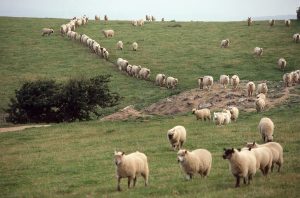
Michael Hamments, Unsplash
The one that has been most accepted is the first, that we are sheep passing through a narrow gate so that we can be counted one by one. This is the regerence in Netaneh Tokef. But the second explanation may shed light on our question of where is Meron: does Meron have a steep incline that makes travelers walk single file? While Mount Meron is a tall and in parts steep mountain, it does not seem to have the narrow passageways indicated by Resh Lakish. A place that does have these narrow passes is far from Meron geographically, but close in sound: Maale Bet Horon, a narrow passageway in the center of the country. There are scholars who say that that is the correct reading of this statement.
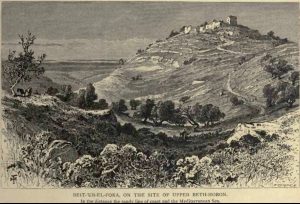
The narrow passage by Bet Horon, Lane-Poole, Stanley, Public domain, via Wikimedia Commons
But a more likely explanation was first offered by Dr. Saul Lieberman, and also written about by Dr. Shmuel Safrai. The term is not Bnei Maron but benumerus: as a numerus. What is a numerus? A Roman army division, where soldiers would walk and be counted one by one, similar to Rav Yehuda’s explanation.
Meron: home of Rabbi Shimon bar Yohai but also of many simple Jews like the Meroni in our tale.








